| Reviews & Columns |
|
Reviews DVD TV on DVD Blu-ray 4K UHD International DVDs In Theaters Reviews by Studio Video Games Features Collector Series DVDs Easter Egg Database Interviews DVD Talk Radio Feature Articles Columns Anime Talk DVD Savant Horror DVDs The M.O.D. Squad Art House HD Talk Silent DVD
|
DVD Talk Forum |
|
|
| Resources |
|
DVD Price Search Customer Service #'s RCE Info Links |
|
Columns
|
|
|
Nanook of the North / The Wedding of Palo
Flicker Alley // PG // March 19, 2013
List Price: $41.95 [Buy now and save at Amazon]
The Movies:
When I was young, growing up in Rochester, New York in the late 60's/early 70's, my mother would bundle me up so I could play in the snow with layers of sweaters and socks, a coat, a hat and mittens an then say "go out and have fun Nanook." I never thought much about it. I just assumed that it was one of those phrases that people used even though no one knew what it meant (like "hoist by your own petard"). That's a testament to the effect Robert Flaherty's 1924 film, Nanook of the North had on the country. Even 50 years later, though it was rarely (if ever) shown on TV or in wide release theatrically, it was still part of the lexicon, in at least a limited sense. Now Flicker Alley has released this influential and far-reaching film, a move that's widely recognized as the first documentary, on a magnificent looking Blu-ray disc chocked full of extras and even a second feature film, The Wedding of Palo. It's great set that's a must-buy for fans of early cinema.
Nanook of the North:
In the early 1910's Robert Flaherty was hired to travel to the
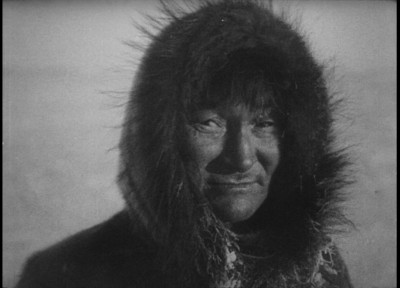
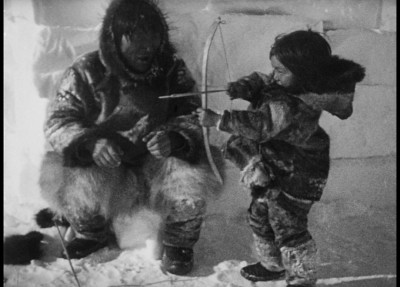
The first film that he made did well at test screenings, but when the negative was destroyed in a fire he decided to return to the
The movie shows an Inuit Chief, Nanoon, his two wives and their children as they work and play. They hunt seals and walrus with harpoons, take pelts to the trading outpost where the proprietor shows them the latest gadget from down south, a phonograph (and Nanook is so amazed and perplexed that he bites the record), they build an igloo, and Nanook teaches one of his young sons how to use a bow and arrow. It's a look at how one family survives in a very hostile environment.
Often cited as the first documentary, the film is justifiable famous, except that it isn't really a documentary by today's definition of the term. That's because most of the movie was staged. One of the most memorable scenes, as well as the funniest, is when Nanook tries to wrestle a speared seal out of a hole in the ice. Every time Nanook pulls the rope attached to the harpoon the seal pulls it back. It's an epic tug-of-war between man and beast... except that he wasn't pulling against a seal. It was really a couple of friends who were pulling the rope from off camera. Flaherty also gathered together a group to hunt a walrus, but he forbade them from employing rifles, which they always used, and made them use harpoons. The record-biting scene was also staged, the tribe knew about records by that time, and even the family was a fiction: Flaherty put it together using the most photogenic tribe members he could find.
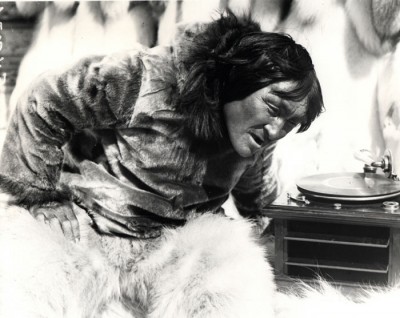
Despite all of this, it's still an important documentary. The film does document how wildlife was hunted at one time, by people who remembered using hand-made tools. It illustrates how they still dressed the animals they killed, and how they would eat them. If Flaherty didn't insist on the participants using the old ways, there would be no photographic record of how it was done.
On top of that, it's an entertaining film. The children are too cute for words, especially in the sequence where a toddler is playing with a fox cub. The way that they make an igloo is impressive, and just seeing the condition that they have to live and how difficult it is to travel even a few miles makes this an engaging movie.

The Wedding of Palo:
This film about the lives of the natives of
While the title is pretty poor, it gives away the ending (!), the film is actually quite interesting. It tells the story of Navarana, an attractive woman who has two suitors, best friends Palo and Samo. Both give her presents and she's flattered by the attention, but the two men start to resent each other and their competition for Navarana's hand nearly turns violent. Instead of fighting though, the village elders insist that they pair face off in a unique contest: a drum duel. The entire village gathers and the two 'combatants' sing sarcastic songs dissing their opponent. The one who makes the crowd laugh the most wins and in this case will be allowed to marry Navarana.
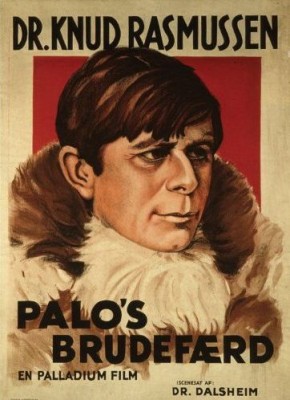
As the contest starts, Navarana's brothers realize that no matter who wins, they will lose. Navarana is their only sister and does all of the domestic work and if she marries she'll leave them. Instead of waiting for the result, they leave (taking Navarana with them) and head off to their winter quarters.
Meanwhile in the battle, Palo has the upper hand and is winning handily... that is until Samo plays his trump card: pulling out a knife and stabbing his opponent. Instead of yelling "foul" everyone runs and Samo seems to suffer no consequences for his deed. He goes off to hunt a polar bear so he can give the pelt to Navarana, while Palo, near death, is treated by a shaman.
This was a very interesting film that I hadn't seen before screening this set. Like Nanook, it presents a look at a culture that no longer exists. The way that disputes were settled is both brilliant and seemingly ineffective. The idea of using humor to resolve differences is inspired, what better way to defuse a situation than be making everyone laugh. On the other hand, one has to wonder if making your opponent the butt of a series of jokes really solves the problem of just exacerbates it and makes it worse.
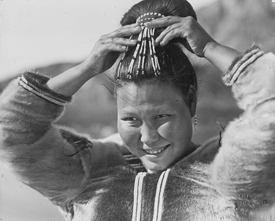
The polar bear hunting scene is also a great document on how such a feat was accomplished. Polar bears are tough, the first time Samo hits a bear with a harpoon it just bounces off his hide doing no damage at all, and you'd think it would be a pretty fair fight, especially if the bear was riled and decided to attack rather than swim from ice flow to ice flow the way this one did.
While some of the plot did leave me scratching my head (why did no one seem to worry that Samo had murderous tendencies?) this film is a wonderful look at a vanished way of life and fun to watch as well.
The Blu-ray:
These features arrive on two Blu-ray disc housed in a single-width keepcase.
Video:
This Flicker Alley set look great. I have the Criterion DVD of the main feature and this new Blu-ray is superior to the older release (which is very good to begin with). For both features and the shorts the 1080p picture is clean and clear, and there's a more detail and contrast than in the Criterion (for Nanook that is... I don't believe the other content has appeared on home video previously). The contrast is excellent and while there is some print damage, this 90 year old film hasn't looked this great in decades. It's an excellent looking collection.
Audio:
The movies come with nice sounding DD 2.0 audio. Nanook of the North is accompanied by an orchestral score that was composed and conducted by Timothy Brock and sounds fine. It's the same score that's on the Criterion version and the music fits the film very well. The sound films are limited to the recording technology of the times, naturally, but the audio sound nice to the ear given the age of the movies. The Wedding of Palo was dubbed in post production and they didn't do a great job of matching the mouth movements but that's an error inherent with the film (and not of huge concern in any case.)
Extras:
Wow! That was my first thought when I started to dive into the extras. Flicker Alley didn't just include a couple of minor items so they could list something on the back of the cover; they went all-out of make an impressive and comprehensive package.
First up is Nanook Revisited, a French documentary from 1988. In this hour-long made-for-TV film director Claude Massot travels back to the locations that Robert Flaherty filmed in 1924 and examines how the Inuit have changed. He is able to track down a couple of descendents of people tangentially associated with the film, the son of friend of Nanook who relates stories his father told him about the filming and the offspring of one of Flaherty's sons (and apparently the son was abandoned by the filmmaker when he finished making his movie). I was disappointed that they didn't dig a little deeper (I've always wondered if Nanook really did die a year or so after the movie was completed or if that was just another of Flaherty's tweaking of get some publicity for the film. As far as I can tell, we only have his word for it.) The second half of the documentary, where the impact of the film on today's (well, 1988's) Inuits is examined, is more interesting. They visit a school where the children as shown how to skin a seal, and then raw seal meat is eagerly eaten by all of the children. It's a nice look at how things have changed while trying to keep their traditions.
There are also five shorts on Arctic life that were made from 1913-1959. Houses of the
Eskimo Hunters of
In addition to the on-disc bonuses there's a wonderful 32-page booklet that contains an excerpt from Robert Flaherty's book, My Eskimo Friends, that deals with his time spent making Nanook as well as an interesting essay on The Wedding of Palo by Lawrence Millman. There are also notes on the other films included in the collection.
Final Thoughts:
This is an amazing set. Just presenting the two features in lovely prints would make this worth the price, but adding an impressive five (!) shorts and an additional documentary the runs over an hour makes this a must-buy collection. It comes very Highly Recommended.
Note: The images do not come from the Blu-ray disc.
|
| Popular Reviews |
| Sponsored Links |
|
|
| Sponsored Links |
|
|
| Release List | Reviews | Shop | Newsletter | Forum | DVD Giveaways | Blu-Ray | Advertise |
|
Copyright 2024 DVDTalk.com All Rights Reserved. Legal Info, Privacy Policy, Terms of Use,
Manage Preferences,
Your Privacy Choices | |||||||













